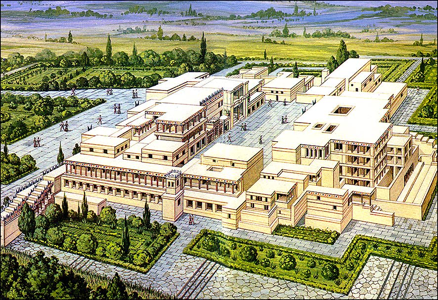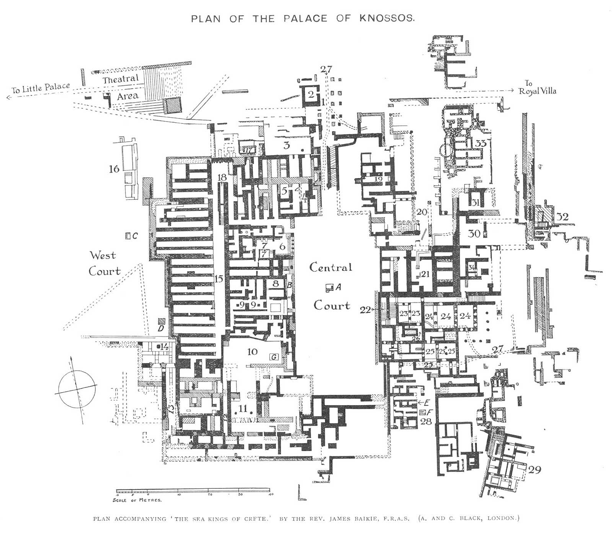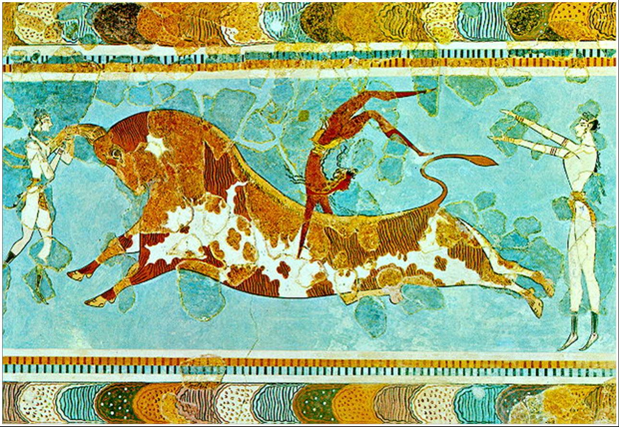Knossos
Knossos is the largest of the “palaces” erected by the Bronze Age Minoan civilization on Crete. Our present interactions with Knossos are the result of the work of Arthur Evans, who excavated the site beginning in 1899. His and later works revealed a highly complex civilization, of which previous material evidence was almost nonexistent.
Evidence of Bronze Age materials associated with Minoan development on Crete begins in the last part of the third millennium B.C.E. The palaces were first erected around 1900 B.C.E., and destroyed by earthquake around 1700, the “Old Palace” period. The rebuilding of the palaces initiates the “New Palace” period in the historical framework used by most, which lasted until another main destruction just before the 14th century, and the subsequent evidence of occupation by Mycenaean peoples.

The palace itself is a huge and sprawling architectural complex, like other Minoan palaces, which is thought to have had a wide variety functions in Minoan society. The structure was made of a combination of stone masonry, rubble, plaster and wood. Unlike the “citadels” of the mainland, there is no evidence of fortification. The centerpiece of the palace was a large paved central court, which measures 27m x 49m at Knossos. The structure was accessed with raised walkways, usually leading to a propylon, or porch. Narrow corridors and ramps ran through the structure, connecting the entrances with rooms, hallways, and the central court, with staircases leading off to unpreserved upper floors. Artifacts discovered in existing rooms have led to the interpretation of their function, and occasionally even the function of the rooms in the upper stories above them. For example, the area of rooms directly west of the central court have been thought of have religious associations. Just to the north lies a bench-lined space considered to be a “throne room” by Evans. Beyond those, a series of long narrow rooms, with pitted floors and lined with large ceramic wares, are interpreted as “magazines” for storage. The rooms directly above these, however, are associated with “banquet and state reception chambers” (Biers 35).

One signature feature of the architecture is the use of a single column in the center of doorways. Minoan columns varied in size and shape, often having a distinctive downward taper and flaring capital. Fragments have indicated that some areas were highly decorated, while other areas show evidence of being painted solid colors, most of often terra cotta red.
In artistic terms, Knossos has also produced significant examples of Bronze Age art. Specifically, the frescoes that decorated parts of the palace are now well known. Minoan frescoes generally include stylized depictions of animals and humans. Among the most famous examples form Knossos are a fragment known as “La Parisenne” depicting a woman’s face, one of flying fish and another depicting “bull vaulting”. Many other important artifacts are drawn from Knossos, such as tablets with inscriptions in the Linear A and Linear B syllabaries.

As seen today, Knossos sits outside the modern town of Heraklion, and serves as a major tourist attraction. Parts of Knossos were reconstructed by Evans, including a large raised “bastion” above the north ramp leading to the central court, and the outer west façade of the palace. Although such reconstructions may help visitors to visually interpret what the site would have looked like, Evans’ use of modern materials has taken a serious toll on the alabaster ruins he built on top of.
by Peter Hatch
Biers, William R. The Archaeology of Greece. Ithaca: Cornell University Press, 1980.
"Knossos." Encyclopædia Britannica. 2007. Encyclopædia Britannica Online. 10 Dec. 2007 <http://www.britannica.com/eb/article-9045803>.
Posted at Dec 11/2007 10:18PM:
keffie: Nice work. What about complicating functionalist interpretations of the use of space?
